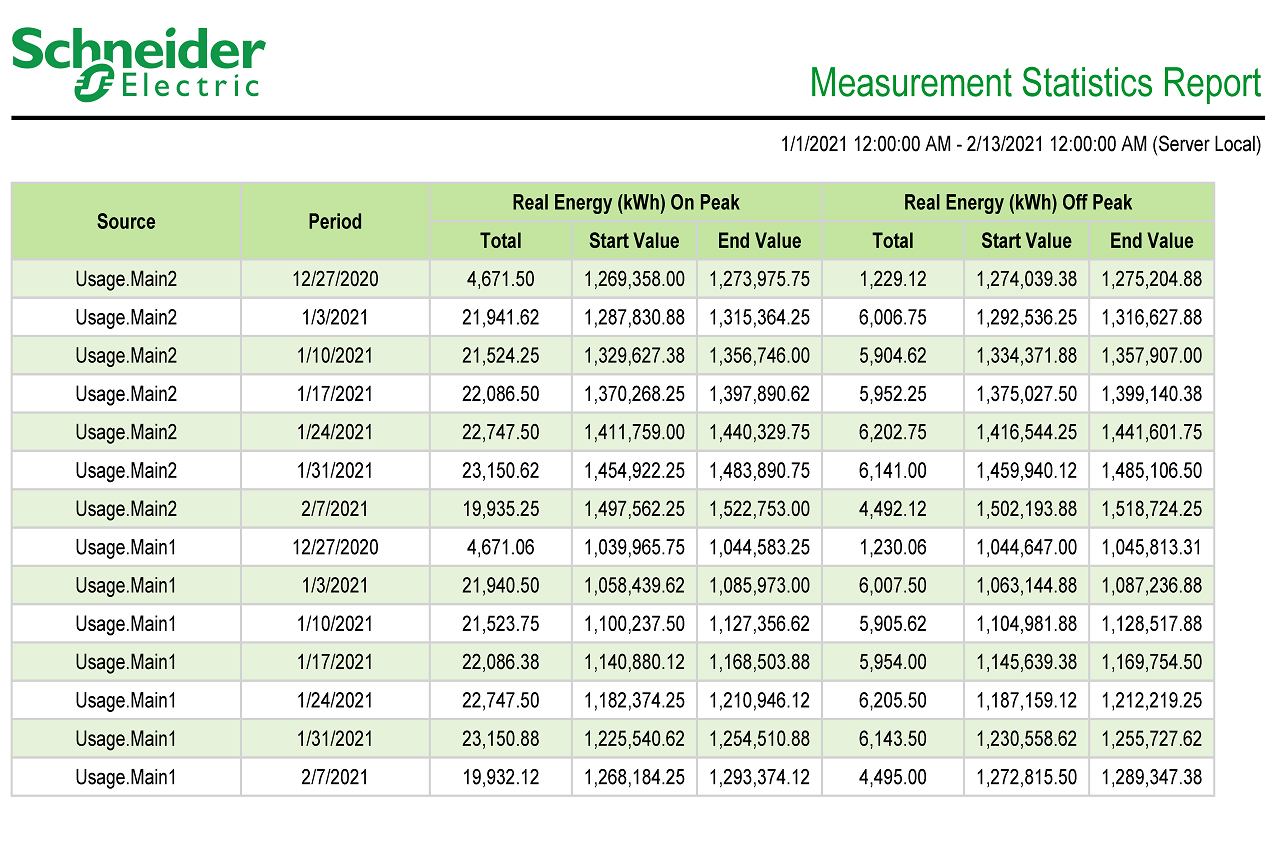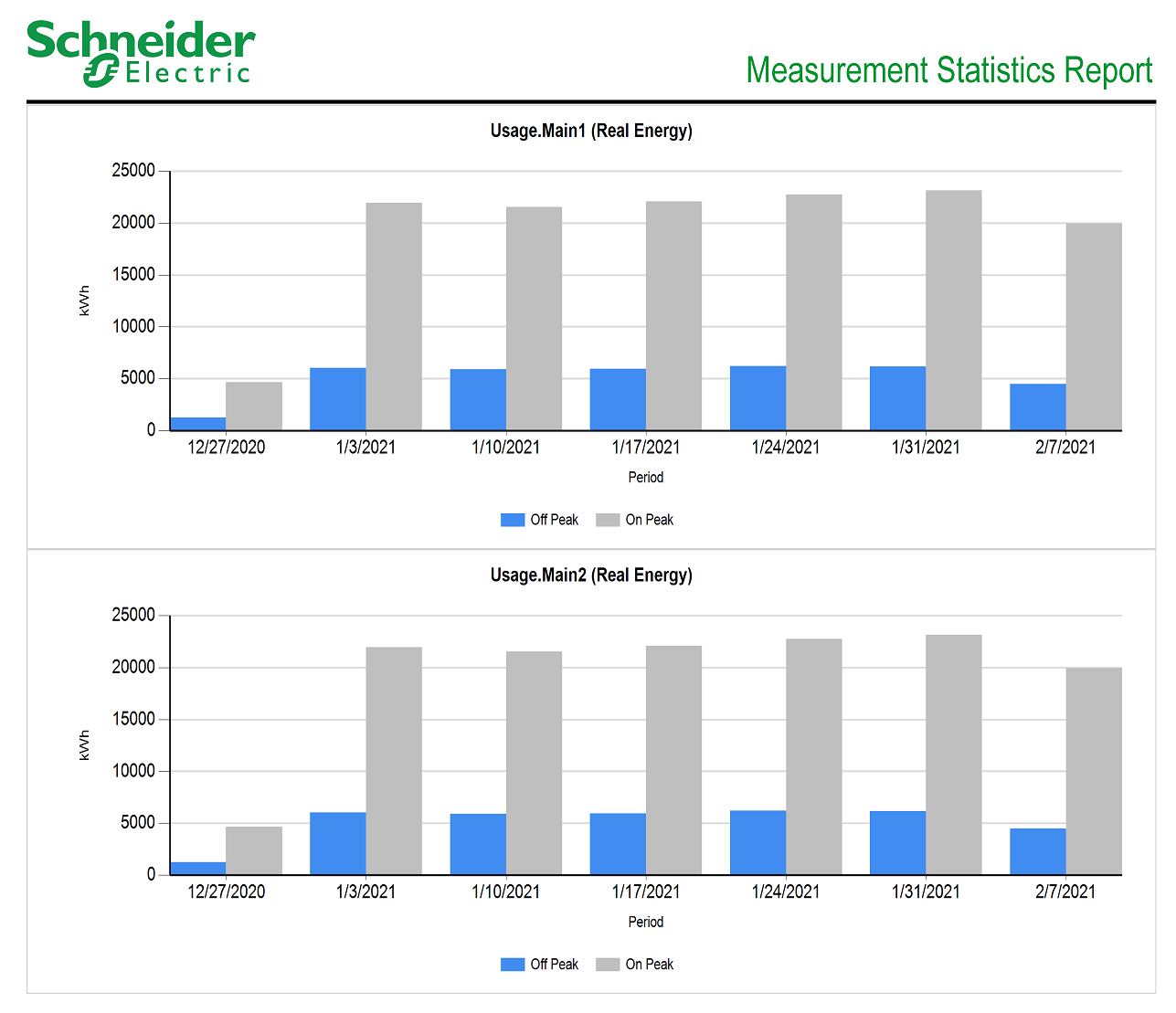Measurement Statistics Report
Summary
The Measurement Statistics Report gives a statistics of logged measurement data in tabular and chart format. The statistics intervals are configurable and the report supports statistics by time of use. Use this report to understand the consumption patterns of your facility or processes.
Prerequisites
- The measurement data must be available as historical data logs in the database.
Report inputs
Type a title for the report in the text box.
The Source Selector dialog provides options to show Devices or Views:
Use the Devices option to select the devices you want to include in the report.
From the Grouping list, select the way in which you want to display the sources (for example by device type or by group name). Click + and - to expand and collapse items in the navigation tree. Click the check box beside a device (or group of devices) to select it. Click Select All or Select None in the top-right corner to select or clear all the check boxes.
After selecting the devices, click OK.
Use the Views option to select a hierarchy view (a tree of relationships) or virtual meters. The hierarchy views and virtual meters are configured in the Hierarchy Manager component. (See the Hierarchy Manager Help for further information about hierarchies, virtual meters, and views.) Click + and - to expand and collapse items in the tree. Click the check box beside any hierarchy item in the tree or any virtual meter to select it.
Click OK after making your selections.
Use this input to select the measurements you want to include in the report.
Click Select Measurement to open the Measurement Selector dialog. Click + and - to expand and collapse items in the navigation tree. For reports where you can select multiple measurements, click the check box beside a measurement (or group of measurements) to select it. For reports where you can only select a single measurement, click the measurement name to select it.
After selecting the measurements, click OK.
Use this input to select the timeframe for the data you want to view in the report.
Select the reporting period from the dropdown list. The timeframe options in the timeframe dropdown are relative to the date the report is run. To run a report that starts and ends in the past, select the fixed date option. Type a start and end date in the date boxes or click the arrows beside the dates to display a pop-up calendar and select a date. Type a time in the time boxes or click the up and down arrows beside the time to adjust the hours or minutes up or down. You can also run a report that starts and ends in the future. You must manually add the future data. You can use any tool to generate future data. For example, use Manual Data Editor to manually enter measurement data.
Select the timezone you want to view timestamps in.
Use this input to select the interval for the data you want to view the statistics in the report.
Select the statistics period from the dropdown list. The available options are Entire Period, Day, Week, Month and Year.
Select if you want to use a time of use (TOU) schedule with this report. If you want to use a TOU schedule, select a TOU schedule from the list. The list shows the existing TOU schedules that are configured in the system. If you have not created a TOU schedule, the field shows that no schedule is available.
Click Yes to include the Time of Use interval selections for non-cumulative measurements. If you click No, the report excludes the Time of Use interval selections. For cumulative measurements, the Time of Use interval selection is always considered.
Select whether or not to include the chart in the generated report. The default is Yes.
Select the sort options of the tabular data from the dropdown list. The available options are Source Name, Period, Maximum Value, Minimum Value, and Total. The selection applies to the entire table. For example, if Maximum Value is selected, then all maximum values across all measurements and Time of Use periods are considered.
Select Ascending or Descending to show the tabular data based on the Sort By selection.
Select an option for the format of the label describing the source. The options are Source Name, Source Description, and Combined Name/Description.
NOTE: The source description is the description that was entered in Management Console or Device Manager for a source, when the source was added or edited.
Click Yes to include data warnings in the report. If there are none, the section is not included. Click No to exclude this section.
Example:


NOTE: This example only shows selected content from the report, it does not show the entire report.